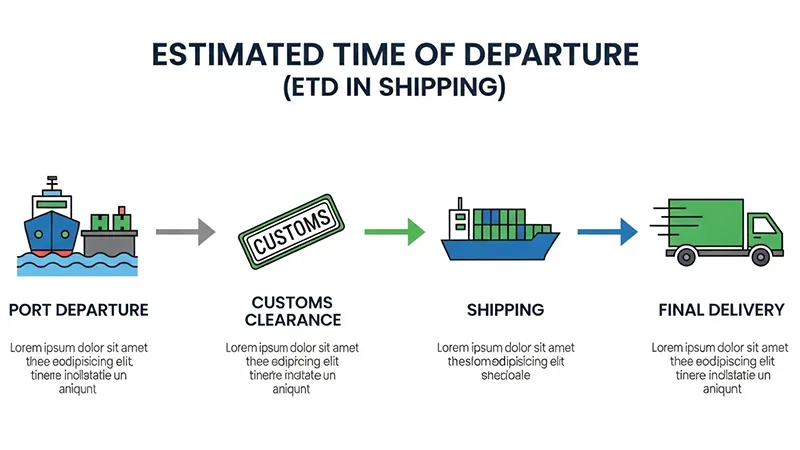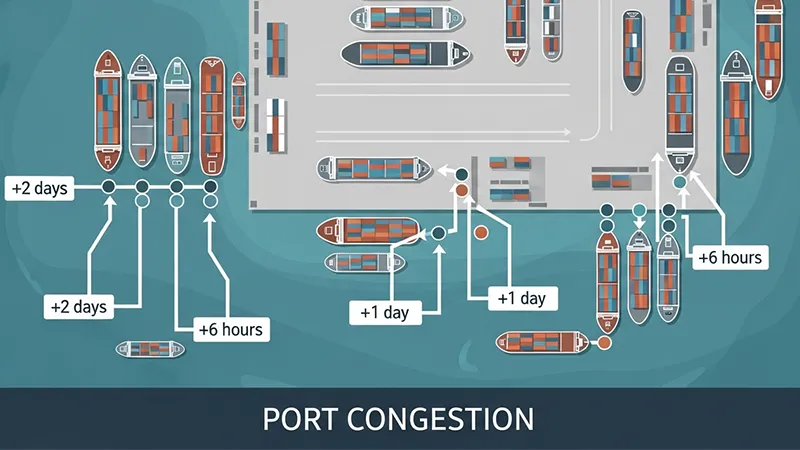What Is Estimated Time of Departure (ETD)?

In the world of transportation and logistics, Estimated Time of Departure (ETD) refers to the projected time when a vessel, vehicle, or aircraft is expected to leave its point of origin, such as a port, airport, or warehouse. This key term is frequently used in international shipping to help stakeholders—such as consignees, carriers, and freight forwarders—plan and prepare for shipments.
Knowing the ETD is essential for effective coordination and smooth operations in the supply chain. By understanding the meaning of ETD and how it impacts your shipping processes, businesses can optimize logistics and avoid delays.
The Definition of ETD: Why It Matters in Shipping
The definition of ETD is simple: it is the time at which the carrier plans to depart from the origin port or terminal. The ETD meaning in shipping is essential for those involved in the logistics process, as it helps stakeholders plan their actions around this expected time frame. Whether it’s for stock management, customs clearance, or coordinating the unloading of goods, the ETD allows everyone in the supply chain to prepare accordingly.
ETD means more than just a scheduled departure—it’s a key piece of information that helps businesses ensure their goods arrive on time, optimize their supply chain, and maintain a smooth operation.
How ETD Impacts Logistics and Shipping Operations

The ETD meaning plays a significant role in various aspects of international logistics and shipping. From coordinating freight schedules to planning inventory management, knowing the ETD in advance helps streamline many processes, reducing the risk of delays and inefficiencies. Here are some of the ways that ETD benefits your shipping operations:
-
Stock Management Optimization: With an accurate ETD ship, businesses can align their stock levels and ensure that they don’t overstock or run out of products. Knowing when goods are expected to leave the port helps with inventory planning, as companies can prepare to receive shipments or schedule restocks accordingly.
-
Coordinating the Shipment Process: The ETD delivery is critical for coordinating the logistics of the goods' transport. It provides a timeline for when the shipment should leave the origin point, allowing both the sender and the receiver to make arrangements for loading, unloading, and further transportation.
-
Timely Delivery: For businesses involved in time-sensitive shipments, the ETD serves as a crucial reference point. Understanding the definition ETD and the projected departure time allows logistics teams to work backward, ensuring that there is enough time for customs clearance, delivery coordination, and final delivery.
-
Preventing Losses from Delays: One of the most significant benefits of knowing the ETD meaning is that it helps avoid costly delays in the supply chain. When stakeholders are aware of any changes to the ETD, they can make necessary adjustments before the shipment is delayed, reducing the risk of loss or missed deadlines.
Factors Affecting the Estimated Time of Departure (ETD)
Although the ETD meaning provides a useful guideline, there are several factors that can affect the accuracy of the ETD. These factors can lead to unexpected delays or changes in the schedule. Understanding what might influence the ETD is essential for businesses to anticipate any potential disruptions in their shipping process.
-
Port Congestion: A common issue that affects the ETD ship is congestion at busy ports. When there is heavy traffic at a port, the vessel may need to wait in line to dock, which can delay its departure time. High demand during peak seasons can exacerbate this issue.
-
Weather Conditions: ETD ship can also be delayed by adverse weather conditions such as storms, hurricanes, or high winds. These weather disruptions affect the safety of the cargo and the ship, resulting in delayed departures and longer transit times.
-
Mechanical Failures: If a vessel or vehicle experiences a mechanical issue, this could push back the ETD. Issues like engine malfunctions or equipment breakdowns are often unpredictable but can be a significant cause of delay.
-
Customs and Documentation Delays: Paperwork, customs processing, and clearance procedures can sometimes take longer than expected, which can delay the scheduled departure time. Incorrect or missing documentation can further exacerbate these delays.
-
Labor Strikes: Labor disputes or strikes at the port or with transport workers can disrupt operations, delaying the ETD ship. These strikes often lead to work stoppages or delays in loading and unloading goods, affecting overall shipment schedules.
-
Production Delays: If the production or packaging of goods is delayed, this can push back the ETD. If products aren’t ready for shipment in time, the departure will be delayed, which can affect the overall delivery schedule.
-
Shipping Space Constraints: During peak transportation seasons, such as holidays or global sales events, ETD might be affected due to tight shipping space. High demand for space on ships, planes, or trucks can cause delays in departures, especially if capacity is limited.
Why Is ETD Crucial for Efficient Supply Chain Management?
The ETD meaning in shipping goes beyond just providing an estimated departure time. It allows the entire supply chain to operate more efficiently by offering a clear timeline for when a shipment will leave the origin. Having a solid understanding of the ETD delivery helps in minimizing delays, improving operational efficiency, and reducing costs associated with late shipments.
When managed effectively, ETD enhances stock management and ensures better coordination across the entire transportation process. From the moment the goods leave the origin, every subsequent step can be planned with precision, reducing uncertainty and keeping operations running smoothly.
Conclusion: Leveraging ETD for Better Shipping Operations

In the context of international logistics, understanding the ETD and its meaning in shipping is essential for ensuring timely and cost-efficient shipments. By taking into account the various factors that can affect the ETD, businesses can plan accordingly and mitigate the risks of delays.
At Zbao Logistics, we recognize the importance of accurate ETD predictions in shipping, especially for Amazon FBA logistics and global fulfillment. Our comprehensive logistics services help businesses optimize their supply chain processes and minimize delays by providing real-time ETD updates. Whether you’re managing shipments for Amazon FBA or other international ventures, we’re here to ensure your goods reach their destination on time and in perfect condition.
Call to Action:
Ready to streamline your logistics? Contact Zbao Logistics today for expert shipping solutions and efficient ETD management to optimize your supply chain.


